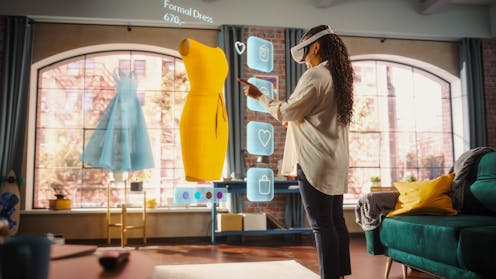Running out of wardrobe space? Maybe you should follow the growing trend for clothes you can’t actually wear
- Written by Kokho Jason Sit, Senior Lecturer in Marketing; Associate Head (Global), University of Portsmouth

Virtual reality has been fashionable for a while now. So perhaps it was only a matter of time before fashion became virtual.
Instead of spending your money on actual clothes to wear on your actual body, you can now buy garments (and accessories) that you will never touch. Also known as digital fashion[1], this is a world where clothes are “worn” only in virtual spaces, such as online games or in the metaverse[2].
Like virtual travel where you never leave your sofa, or a virtual bungee jump without risk of injury, virtual fashion is convenient and accessible. It is also getting more popular, with some sources forecasting[3] that this particular side of the fashion industry could soon be worth tens of billions of dollars every year.
The growth potential predominantly comes from fashion brands using virtual products to advertise and innovate, and ultimately generate more sales. They can use digital clothes to experiment, gauge interest and explore new markets.
Vans, for example, created a virtual skatepark[4] in collaboration with the game developer Roblox where users could practice their online skating skills, and buy exclusive clothing, shoes and other gear. A backpack here[5] would cost 400 Roblox units of online currency, equivalent to around £5[6].
Meanwhile, the luxury brand Gucci created a virtual gallery[7] (also with Roblox) where visitors could view, “try on” and buy digital items using blank, genderless, humanoid mannequin avatars.
The gallery had different themed rooms from which the avatars would absorb certain visual elements. Users could then screenshots to share on social media.
Zara has collaborated with Zepeto[8], a South Korean metaverse platform, to do something similar.
All these companies have seen how e-fashion can serve as a useful strategy to engage with consumers and promote imaginative products – and ultimately drive brand awareness and sales.
Read more: 3D printing in fashion promises to be huge – so what's holding us back?[9]
Elsewhere, some have previously argued that e-fashion could actually help to make the fashion industry more sustainable[10] by eliminating some of the environmental issues[11] associated with the industry like waste and carbon footprints.
The theory was that if people spent most of their working day in the virtual world, then digital fashion could be a more sustainable alternative to real-world fashion. You could effectively wear the same old jeans and hoodie day after day, while dressing in the latest trends online.
But ideas of a fully immersive digital world have so far not materialised, and fashion’s issues with sustainability remain[12], driven by the widespread impulse to keep up with the latest fashion, dress cheaply and dispose of items quickly.
The real-world presents digital fashion with further hurdles in its bid to become mainstream.
Some critics would argue that e-fashion lacks “touch authenticity”[14] – the chance to feel and try a design before buying. Others, more simply, would point out that the biggest problem with digital clothes is that you can’t actually wear them.
And our research[15] suggests that the market for e-fashion remains relatively niche. So far, it appeals mostly to hardcore enthusiasts who enjoy exploring new shopping experiences.
These consumers, often passionate about fashion, expression[16] and technology[17], are the ones most likely to pay for and use e-fashion. They see it as a fun and effective way to combine their interests.
With a few clicks, they can “try on” e-fashion items, personalise them, and then capture and share the results, enjoying a creative outlet for their desire to try new clothes, styles and colours. And it provides brands and designers a way of trying out new ideas, some of which may be impossible to produce in the real world.
References
- ^ digital fashion (www.voguebusiness.com)
- ^ the metaverse (theconversation.com)
- ^ sources forecasting (www.businessoffashion.com)
- ^ created a virtual skatepark (www.forbes.com)
- ^ backpack here (roblox.fandom.com)
- ^ equivalent to around £5 (www.invenglobal.com)
- ^ virtual gallery (www.voguebusiness.com)
- ^ collaborated with Zepeto (ww.fashionnetwork.com)
- ^ 3D printing in fashion promises to be huge – so what's holding us back? (theconversation.com)
- ^ more sustainable (www.theinterline.com)
- ^ environmental issues (www.forbes.com)
- ^ remain (theconversation.com)
- ^ Sasha Ostapiuk/Shutterstock (www.shutterstock.com)
- ^ “touch authenticity” (www.tandfonline.com)
- ^ research (doi.org)
- ^ fashion, expression (theconversation.com)
- ^ technology (theconversation.com)







